Rio 2016: Newsround's Guide to Paralympic sports
- Published
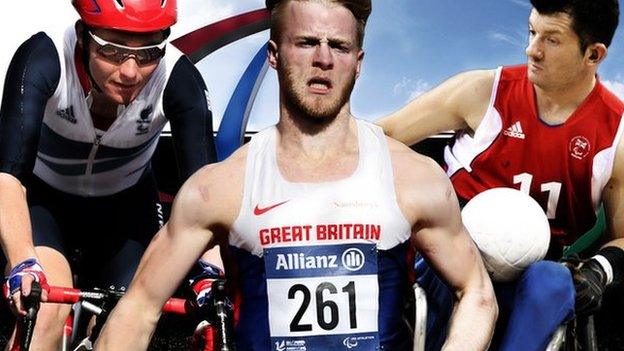
Cyclist Dame Sarah Storey, sprinter Jonnie Peacock and wheelchair rugby's Alan Ash will be hoping to lead the gold charge for GB at the Paralympics
The 2016 Paralympic Games take place between 7-18 September in Rio, Brazil.
Athletes will take part in 22 Paralympic sports over the course of 11 days of competition.
Each sport has different physical demands and so has its own set of classifications to decide which athletes can compete in each event.
Here is Newsround's quick guide to the Paralympic sports that will be on show in Rio.

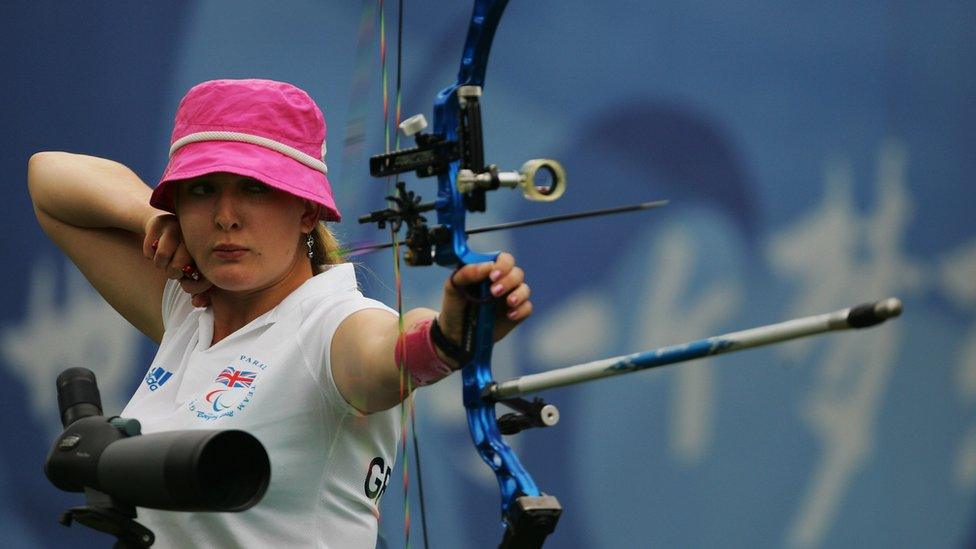
Aim of the game
Archery might sound simple on paper but it's definitely not easy. Competitors have to hit the centre of a target, known as the 'bull's eye', from a distance of 50m or 70m.
Why should you watch?
Whether using their hands, mouth or feet, these athletes are living proof that there are no limits when the challenge is to hit the bull's eye.
Classification
Archery is open to athletes with a physical disability and classification is broken up into three classes:
ARW1: Wheelchair users with a disability in all four limbs.
ARW2: Wheelchair users with full arm function.
ARST (standing): Athletes who compete in a standing position and also those who need to use a stool for support because of poor balance.

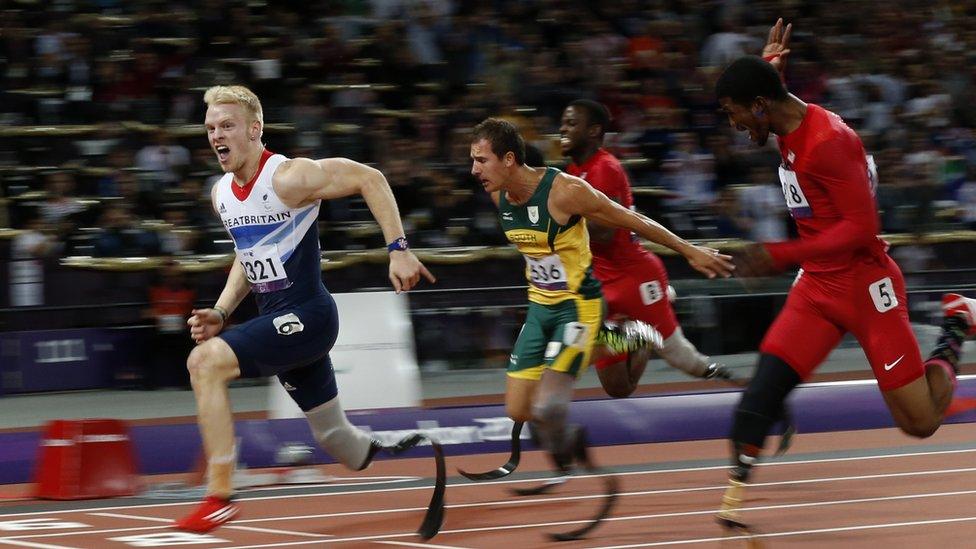
Aim of the game
Athletics has been part of the Paralympic Games since the first edition in Rome, Italy, in 1960. The mission for athletes is always the same - to beat your opponents' performance, whether in running, jumping or throwing events.
Why should you watch?
Nowhere else is the skill, strength, speed and courage of Paralympic athletes more on display than in athletics competition. Paralympics GB have some superstars going for gold too, including David Weir, Jonnie Peacock and Hannah Cockroft.
Classification
All disability groups can compete in athletics but a system of letters and numbers is used to distinguish between them.
A letter F is for field athletes, T represents those who compete on the track, and the number shown refers to their disability.
11-13: Track and field athletes who have problems with their eyesight. Blind athletes compete in class 11 and are blindfolded and run with a guide runner. Athletes in class 12 are visually impaired but may choose to run with a guide.
20: Track and field athletes who are intellectually disabled. There are three events for men and women in the Rio programme - 1500m, long jump and shot put.

31-38: Track and field athletes with cerebral palsy or other conditions that affect muscle co-ordination and control. Athletes in class 31-34 compete in a seated position; athletes in class 35-38 compete standing.
40: Track and field athletes with short stature, also known as dwarfism.
42-46: Track and field amputees. In class 42-44 the legs are affected and in class 45-46 the arms are affected. Athletes in these classes compete standing and do not use a wheelchair.
T51-54: Wheelchair track athletes. Athletes in class 51-53 are affected in both lower and upper limbs. T54 athletes have some ability in their legs and trunk, which is the central part of the body that includes the chest, back and belly area.
F51-58: Wheelchair field athletes. Athletes in F51-54 classes have limited shoulder, arm and hand functions and no trunk or leg function while F54 athletes have normal function in their arms and hands. In the F55-58 classes the trunk and leg function increases.

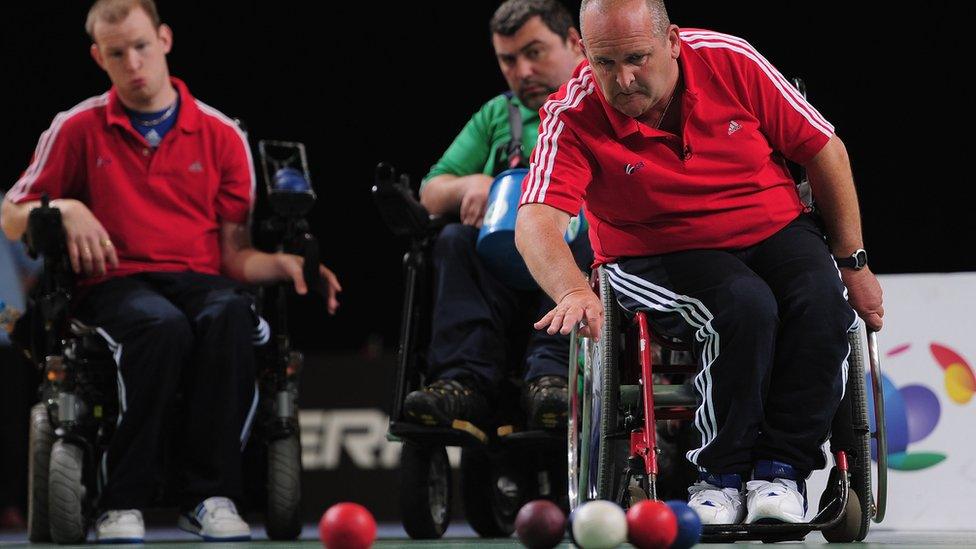
Aim of the game
Players must throw or roll their coloured balls as close as possible to a white target ball, called the jack, with the winner being the player or team with the most balls near the jack.
Why should you watch?
Boccia is a game of strategy in which players show great skill and determination to overcome their impairments. Also, the sport is incredibly tense because one good, or bad, throw can change the outcome of the whole competition.
Classification
Boccia is open to athletes with cerebral palsy - a condition that affects the way the brain communicates with a person's muscles - and other severe physical disabilities who compete from a wheelchair. The classification is split into four classes.
BC1: Players with cerebral palsy who are able to use their hands or feet to consistently throw a ball into play. BC1 athletes may have a helper on court to pass them their ball before each shot.
BC2: Players with cerebral palsy who are able to use their hands to consistently throw a ball into play and have greater functional ability than a BC1 athlete.
BC3: Players with cerebral palsy or other disability, who are unable to throw or kick a ball into play and as such are allowed to use a device such as a ramp to throw the ball into play. They are supported by an assistant ("ramper") who adjusts the ramp on the instructions of the player.
BC4: Players who do not have cerebral palsy but have another condition, which affects the movement in all four limbs, such as muscular dystrophy, spina bifida and tetraplegia.


Lagoa Rodrigo de Freitas will be the Paralympic canoe and rowing venue
Aim of the game
Canoe makes its Paralympic Games debut in Rio. Athletes in kayaks must complete a straight 200m course across calm waters in the fastest possible time.
Why should you watch?
This is a chance to witness history being made as the first ever Canoe champions will be crowned at the Paralympic Games. Also, the races will take place at, arguably, the most beautiful sporting venue in Rio - Lagoa Rodrigo de Freitas.
Classification
Athletes compete in kayaks using a double blade paddle. These athletes all have a physical disability and are grouped into three sports classes.
KL1: Athletes in this sports class have no or very limited trunk and no leg function.
KL2: Athletes in this sports class have some trunk and leg function; they are able to sit upright in the kayak. Along with this, they will have limited leg movement during paddling.
KL3: Athletes in this sports class have trunk and partial leg function, they are able to sit with trunk in forward position in the kayak and able to use at least one leg or prosthetic leg.

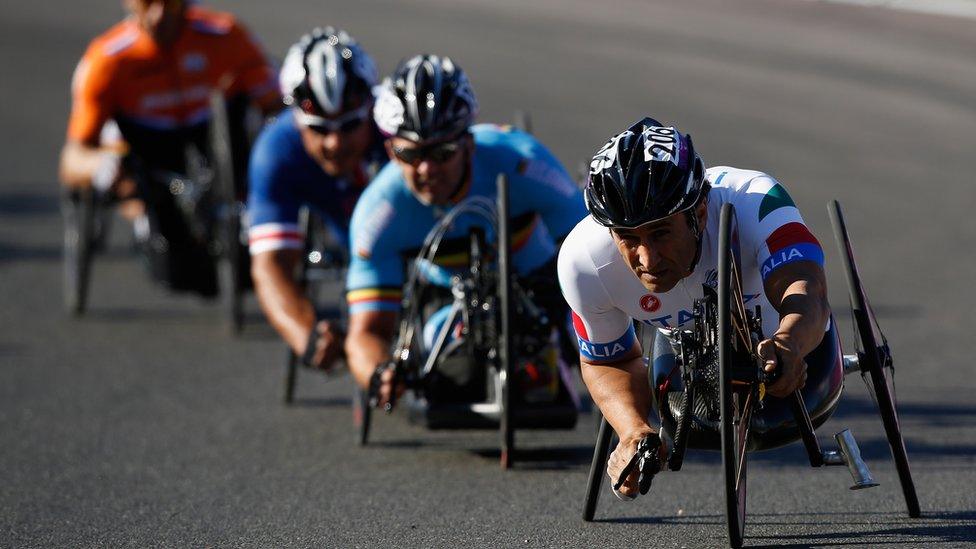
Aim of the game
Road cycling: On bicycles, tricycles, handbikes and tandems, athletes compete against each other in long-distance road races and against the clock in time trials.
Track cycling: Cyclists compete to achieve the fastest times on a 250m track at the velodrome.
Why should you watch?
Whether it's on the track or out on the road, this thrilling sport combines explosive speed and smart tactics. Oh, the Brits are very good on a bike too so expect meals!
Classification
Cycling is open to amputees, 'les autres' (athletes whose disability does not fall under one of the other categories), athletes with cerebral palsy and visually impaired athletes, competing in individual road race and track events.
Athletes with physical disabilities either compete on bicycles (road and track), handcycles or tricycles (road only).
Visually impaired athletes compete on two-seater bicycles along with a guide who can see clearly.
Handcycle sport classes H1-4: Cyclists in H1-3 compete in a leaning back position. H1 athletes have no trunk or leg function and limited arm function while H3 athletes have no leg function but good trunk and arm function. H4 athletes sit on their knees and use their arms and trunk.
Tricycle T1-2: Races for athletes who are unable to ride a bicycle because of a condition affecting their balance and co-ordination, which is the ability to use different parts of the body together smoothly. Athletes in the T1 class have more serious co-ordination problems than T2 athletes.
Bicycle C1-5: Cyclists may have a condition like cerebral palsy or have a leg or arm amputation. C1 athletes have the most severe limitation while C5 athletes meet the basic disability requirements.


Aim of the game
Para-dressage is the only event on the Paralympic programme. The rider must get the horse to perform c movements - such as steps, trots and canters - and freestyle routines choreographed to music.
Why should you watch?
There are dancing horses! What else do we need to tell you?! Riders are not the only ones to get medals - horses are awarded too!
Classification
Athletes are divided into five categories. The lower the class number, the greater the disability.
Classes 1(a) and 1(b): Mainly wheelchair users, athletes with little trunk control and/or impairments in all four limbs or no trunk balance and good upper limb functions
Class 2: Riders have a very limited ability in both lower limbs and a good trunk balance, or milder limitations in upper and lower limbs with reduced trunk control. Some use a wheelchair in daily life.
Class 3: Typically athletes who can get around without assistance. Riders may have impairments in both arms or have no arms, or moderate impairments of all four limbs. This category also includes blind riders and those with conditions such as dwarfism.
Class 4: Athletes with impairments in one or two limbs or some visual impairment

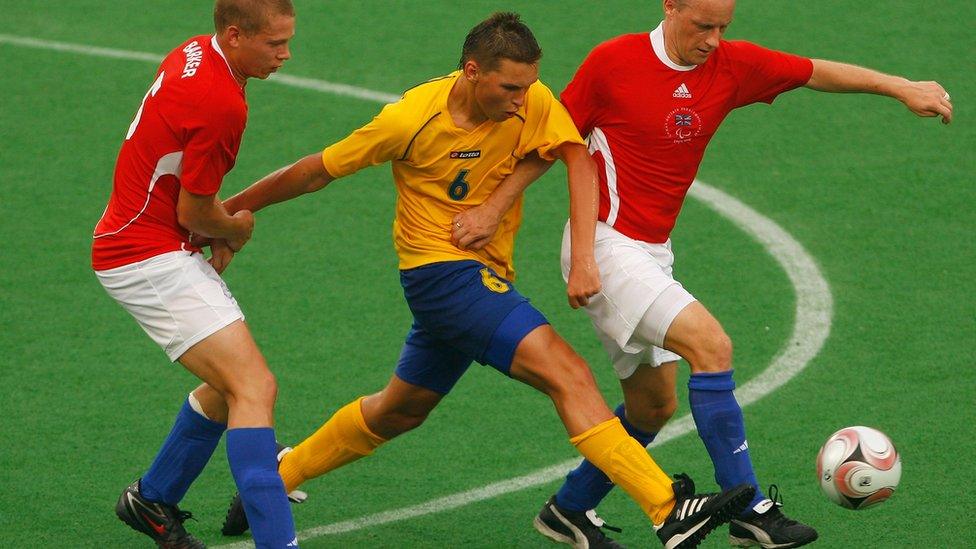
Aim of the game
5-a-side: This version is adapted for people with eyesight problems. Outfield players must wear eye shades and the ball makes a sound that players can follow. Two teams try to outscore each other and are directed by their coach, guide and goalkeeper, who can see.
7-a-side: This version is adapted for players with cerebral palsy. Two teams of seven players try to put the ball in their opponent's goal, while defending their own.
Why should you watch?
Technique, tough tackling and lots of goals - you will be blown away by the skills of the players, and thrilled by the attacking football.
Classification
Seven-a-side football consists of players from the C5, C6, C7 and C8 divisions, rated according to limb control and co-ordination problems when running.
All classes are made up of athletes who are able to walk about. The lower the class number, the greater the physical disability.
At least one C5 or C6 class athlete must be on the field at all times and a team is not allowed to have more than two C8 players on the field.

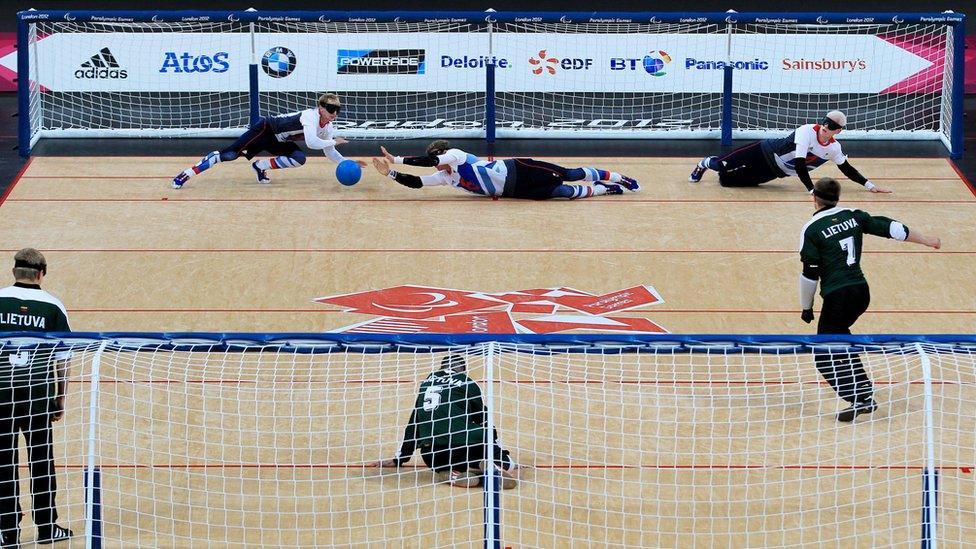
Aim of the game
Goalball is played by athletes who are blind or have eyesight problems.
Two teams of three players try to score points by throwing a ball at high speed into their opponent's goal at the other end of the court.
Participants wear black-out masks to ensure everyone, whether blind or visually impaired, competes equally.
The ball has bells inside it to help the players know where it is and, as a result, the game is played in total silence.
Why should you watch?
Fast-paced sport that switches so quickly between attack and defence. The ball can reach speeds close to 60 miles per hour.
Classification
There is no classification in this sport.

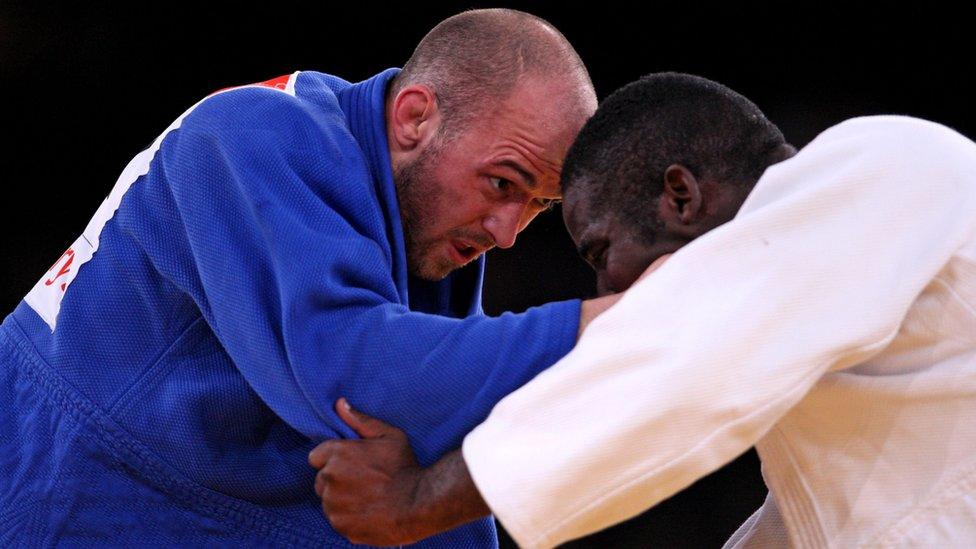
Aim of the game
Judo is contested by athletes with eyesight problems only.
Competitors must try to throw their opponent onto the ground with their back on the floor, holding them on the ground for 20 seconds or force them to give up.
The main difference is that athletes begin the bout holding each other rather than apart.
Why should you watch?
Bouts are crammed full of throws, strength and drama. A judo player can turn a fight around in a second.
Classification
There is no classification in this sport. Competitors are split into weight categories instead.


Aim of the game
Athletes compete to lift the heaviest weight whilst laying face upwards on a bench.
Why should you watch?
Powerlifting is home to the world's strongest Paralympic athletes. Watch in amazement as very powerful people lift some very heavy weights.
Classification
Powerlifting is open to all athletes with a physical disability and is classified by weight alone.
Powerlifters competing at the Paralympics have disabilities in their lower limbs or hips, including paralysis, cerebral palsy and lower limb amputation.
Both male and female competitors take part in 10 weight classes.


Aim of the game
Rowing boats across all events race over a straight 1000m course. The boat that crosses the finish line first is the winner.
Why should you watch?
Rowing has it all - power, speed and nail-bitingly close finishes. The sport will also take place in Rio's beautiful lagoon called of Lagoa Rodrigo de Freitas.
Classification
Rowing is divided into four boat classes.
AM1x: A fixed-seat single scull boat for men. Athletes have full movement in their arms only.
AW1x: A fixed-seat single scull boat for women. Athletes have full movement in their arms only.
TA2x: A two-person, mixed-gender scull for athletes with trunk (the central part of the body that includes the chest, back and belly area) and arm movement only.
LTA4+: A two-male and two-female boat, plus a guide called a cox, with sliding seats. Open to athletes with an impairment but who have movement in the legs, trunk and arms. A boat can include a maximum of two visually impaired athletes who wear blindfolds during training and competition.

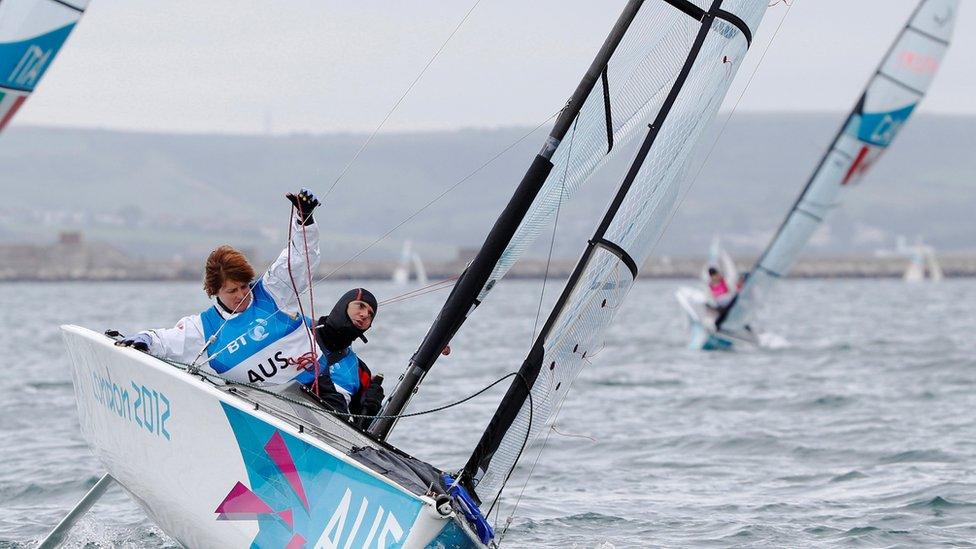
Aim of the game
Powered only by the wind, sailing boats crewed by athletes must make their way around a specially-designed course on the water faster than their opponents.
Why should you watch?
All sailing events are mixed, with men and women competing together in the same races. The unpredictable weather conditions make sailing great to watch too.
Classification
Sailing is a multi-disability sport where athletes from the amputee, cerebral palsy, visually impaired, wheelchair and 'les autres' (athletes whose disability does not fall under one of the other categories) groups can compete together.
There are three sailing classes: the Sonar, which is a mixed three-person crew, the Skud-18, a mixed two-person class, and the 2.4mR event, which is single-crewed.
Competitors are ranked according to a points system from one to seven, where low points are given to the severely disabled and high points for the less disabled.
Each crew of three is allowed a maximum of 14 points between them.
In the Skud-18 category, one sailor has a more severe level of disability while the other must have a minimum level of disability that prevents them competing on equal terms with able-bodied sailors.
Single-handed sailors must have that same minimum level of disability.


Events will take place at the Olympic Shooting Centre
Aim of the game
Competitors have to hit targets in order to score more points than their opponents.
Why should you watch?
Shooting is the ultimate test of accuracy and nerves with men and women compete head-to-head under the same conditions.
Classification
Shooters are divided into wheelchair and standing groups.
These divisions are split into six smaller classes, each of which determines the type of equipment the competitor is allowed to use.
SH1: For pistol and rifle competitors who do not require a shooting stand.
SH2: For rifle competitors who have an upper limb disability and require a shooting stand.


Aim of the game
Teams, made up of six players, aim to hit a ball over a net and land it within the opposition's court. Teams have three passes before the ball has to go over the net.
Why should you watch?
Sitting volleyball is one of the fastest and most exciting sports at the Paralympic Games. Expect a lot blocks and smashes at the net!
Classification
Sitting volleyball is contested by athletes with a physical disability.
There are two classes called Minimally Disabled (MD) and Disabled (D) and a team may only have one MD player on the court while the other five players have to be class D.

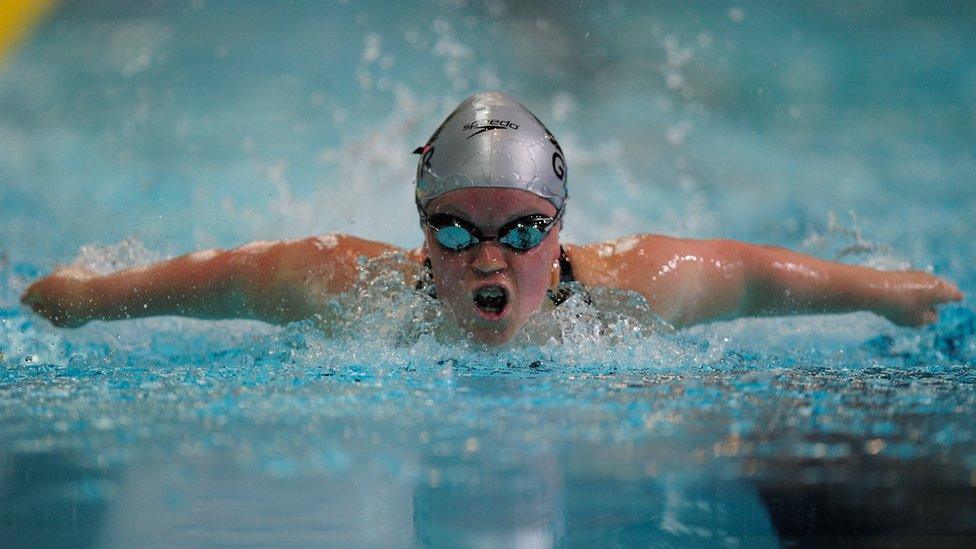
Aim of the game
One of the most recognisable sports at the Games, swimmers must complete a set distance inside the pool in the shortest possible time to win gold.
Why should you watch?
British superstars Ellie Simmonds and Ollie Hynd will be looking to bag more Paralympic golds in the pool.
Classification
Swimming is the only sport that combines the conditions of limb loss, cerebral palsy (co-ordination and movement restrictions), spinal cord injury (weakness or paralysis involving any combination of the limbs) and other disabilities (such as dwarfism) across classes.
1-10: Allocated to swimmers with a physical disability. The lower the number, the more severe the disability.
11-13: Allocated to swimmers with eyesight problems.
14: Allocated to swimmers with an intellectual disability.
The letter S before a number represents the class for front crawl, backstroke and butterfly. SB is for breaststroke, and SM shows the class for individual medley.
In any one class, swimmers may start with a dive or already in the water.
Swimmers may have a classification that changes according to their event they're racing in. For example, it may switch between breaststroke and backstroke, according to the effect of their disability on the event in question.

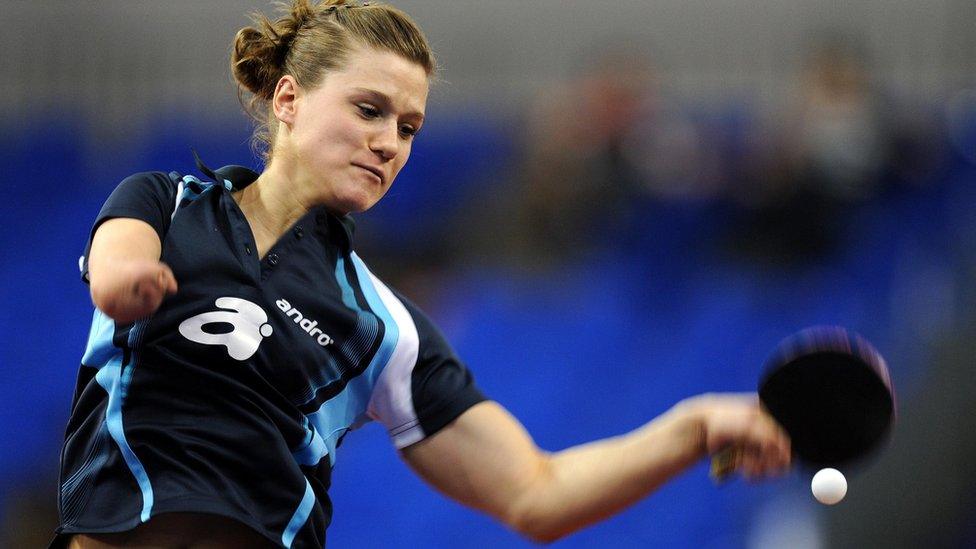
Aim of the game
There's no difference to Olympic table tennis. Each player must use a bat to hit the ball over the net onto the opponent's side, and wins a point if the other player fails to return it.
Why should you watch?
Quick-fire matches with players spinning and smashing the table tennis ball. Blink and you might miss a point in this fast-paced sport.
Classification
Table tennis is played by athletes with a physical or intellectual disability divided into 11 classes.
1-5: Athletes competing from a wheelchair, with class one the most severely disabled and class five the least disabled.
6-10: Ambulant athletes, with class six the most severely disabled and class 10 the least.
11: Athletes with an intellectual disability.

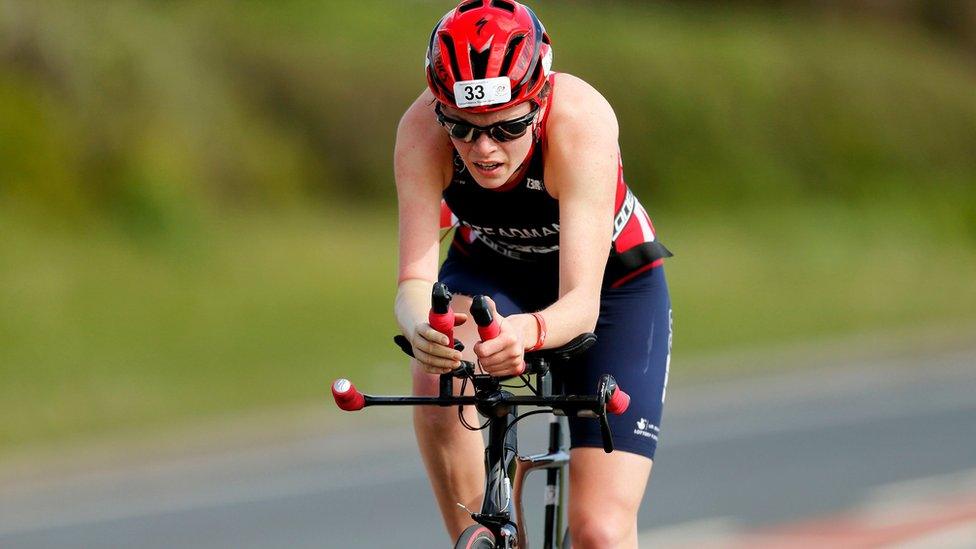
Britain's Lauren Steadman is a multiple world champion in triathlon, which will make its Paralympic debut in Rio
Aim of the game
Athletes race to finish 750m of Swimming, 20km of Cycling followed by a final 5km run in the quickest time.
Why you should watch?
Rio will see the first Paralympic champions crowned in the sport of triathlon.
Classification
There will be three classes of events for men - PT1, PT2, and PT4:
PT1: Para-triathletes in this class swim, cycle on a handbike and compete in a racing wheelchair for the run section. Athletes include those with, but not limited to, issues with muscle power, range of movement, leg amputations and spinal cord injuries.
PT2: This sport class includes athletes with a severe movement disabilities. Amputees may use approved prostheses or supportive devices during the running and cycling stages.
PT4: Athletes with less severe movement disabilities such as muscle power and missing limbs. Athletes may use approved prostheses or supportive devices during the running and cycling stages.
Women will compete in the PT2 and PT4 as well as class PT5:
PT5: Para-triathletes in this sport class have eyesight problems. They swim, ride a two-seater bicycle and run with a guide, who can see clearly.


Aim of the game
Two teams of five players in wheelchairs must try to score points by throwing the ball into the opposing team's basket as many times as possible before time runs out.
Why should you watch?
These wheelchair warriors never fail to deliver exciting action. Tune in if you enjoy pin-point shooting, slick dribbling and incredible competitiveness.
Classification
Basketball is open to wheelchair athletes, whose impairments may include paralysis below the waist, lower limb amputation and cerebral palsy.
Athletes are classified according to physical ability and are given a points rating between one and 4.5. One point is for the most severe disability, 4.5 is the least.
The five players on the court may not go over a total rating of 14 points at any time.


Aim of the game
Two rival fencers try to strike the target area on each other's body using a long blade, which does not have a sharp tip.
Why should you watch?
It's packed full of skill, speed and accuracy. En garde!
Classification
Fencing is open to wheelchair athletes, whose impairments may include spinal cord injuries, lower limb amputation and cerebral palsy and whose conditions stop them from competing against standing, able-bodied fencers.
Athletes competing in this event are split into two classes.
Category A: Athletes with good balance and recovery, and full trunk movement.
Category B: Athletes with poor balance and recovery, but full use of one or both upper limbs.

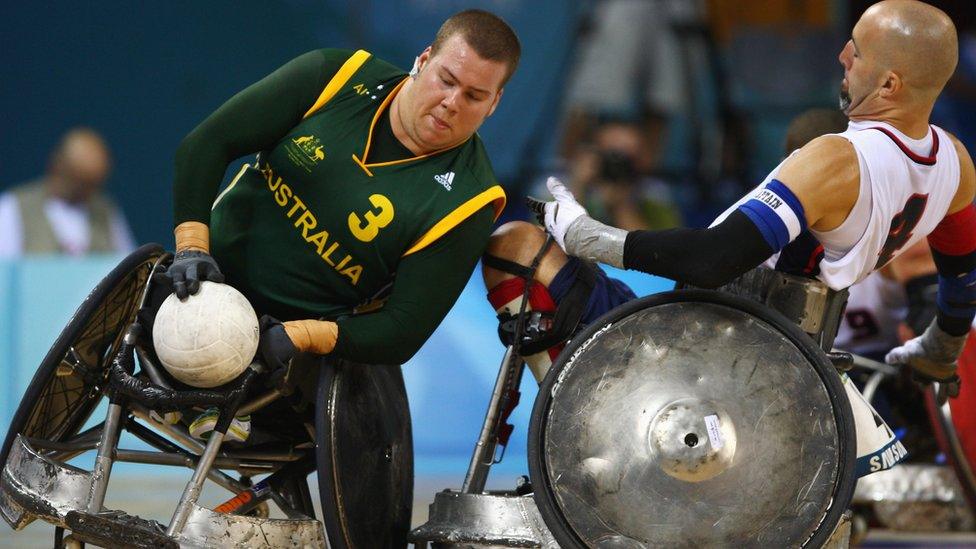
Aim of the game
It might be called wheelchair rugby but this unique sport has more in common with basketball and handball. Two teams of four in specially-made wheelchairs pass a ball between them in a bid to cross the opponent's goal line to score.
Why should you watch?
Full of action, bravery, skill and strength, wheelchair rugby is an exciting game to watch.
Classification
Wheelchair rugby athletes are classified using a points system, with the most severely disabled athletes being graded at 0.5 points, rising to 3.5 points for the more able.
Each team is made up of four players and is allowed a maximum of eight points on court at any one time.

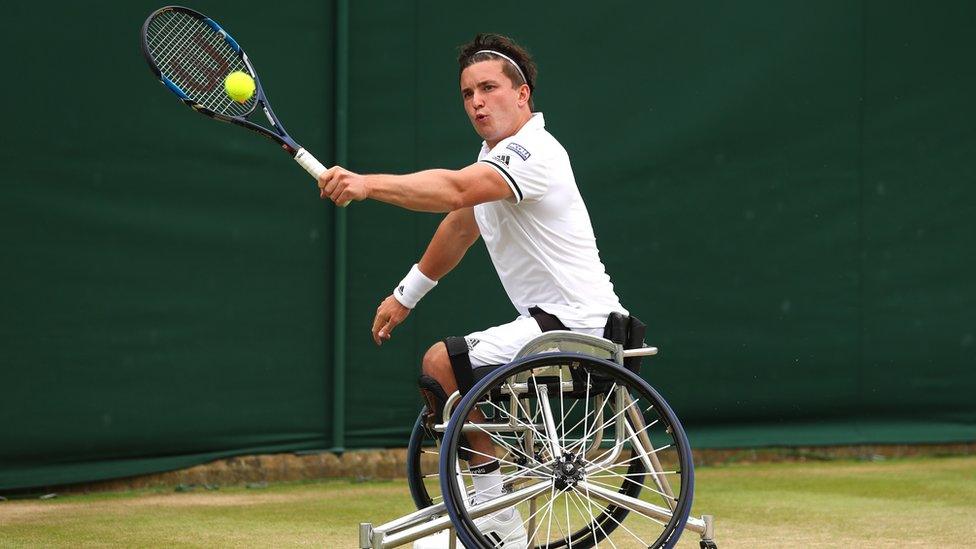
Aim of the game
Using a racket, players must hit the ball over the net into their opponent's half of the court, scoring points if their rival does not manage to return it.
Players are allowed two bounces of the ball, the first bounce being within the marked area of the court.
Why should you watch?
If you are a tennis fan, you will love this! Players hit great shots whilst moving skilfully around the court in their wheelchairs.
Classification
Tennis is played from a wheelchair with two classes - open and quad, where an athlete has a disability in three or more limbs.
- Published1 September 2016

- Published22 August 2016

- Published18 September 2019
